
How to be a successful tourism company online
Having a website with beautiful, engaging images, inspirational videos and informative, well-written content has become the norm for tour operators across the globe. Europeans mostly research and book their travel experiences online. To compete effectively, local tour operators need to have a strong online presence with a website and social media platforms. With careful planning, execution and monitoring, there are plenty of opportunities for local tour operators to improve the effectiveness of their online presence.
Contents of this page
- Recognise why you need to be online
- Reach and sell to consumers online (B2C)
- Find partners to grow your online business (B2B)
- Develop a digital marketing strategy
- Creating or improving your website
- Produce good content for your digital channels
- Take online bookings
- Choose social media platforms
- Use artificial intelligence (AI) in tourism
- Benefit from online marketing and advertising
- Continuously monitor and evaluate your online activities
1. Recognise why you need to be online
Online sources are widely used throughout Europe to research and plan holidays and trips. It is estimated that 81% of travellers use the internet to research their travel destinations.
If you want to compete for European business, whether you want to build business partnerships or make consumer sales, it is essential you have an online presence. A website is the most common way to be present online. Most generations are familiar with websites these days.
European tour operators often use online sources to find new ground operators to do business with. Your website might be the first impression they have of your business. If you are not present online, it is unlikely they will find you at all.
Tourists consult lots of different types of websites, including European and local tour operator websites, travel blogs, destination websites, travel magazines, online travel agents (OTAs) and social media platforms for inspiration. Many go on to book and pay online, particularly younger generations.
Figure 1: Use attractive images on your website and social media
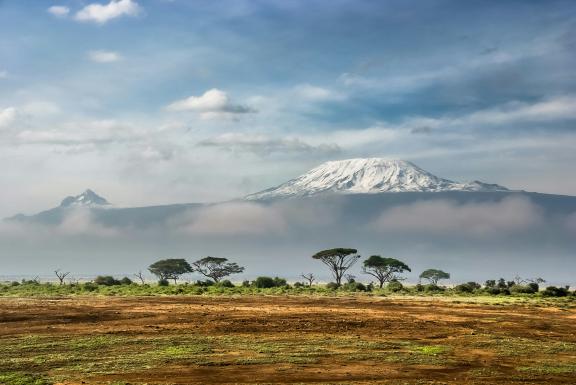
Source: Sergey Pesterev at Unsplash, 2017
The other way to be online is by using social media platforms, particularly Facebook, Instagram, YouTube and TikTok. These platforms are very popular amongst younger generations. The travel industry uses social media platforms to reach consumers as in general. They aim to build awareness and usually point users to company websites for additional information and/or online booking.
LinkedIn is the preferred platform for business.
These are some good reasons to have your own website:
- To reach business partners (Business to Business or B2B) and travel consumers (Business to Consumer or B2C).
- To create your own brand and personalise your business in the way that you would like to be seen. Having a strong brand is another way to generate trust and confidence amongst your target audience.
- A well designed website that features authentic and inspirational content and has a strong USP (unique selling point) helps to build trust and confidence among your buyers.
- A website gives you the opportunity to showcase the best photos and videos of your destination, your trips and your experiences. Inspirational photos and stimulating videos attract attention and can be more convincing than text.
- A website gives you the opportunity to present yourself or your company as an ‘expert’. You could feature detailed information about places of interest in your area, the local culture and traditions and travel tips. The more you present yourself as a specialised ‘one-stop shop’, the more useful your website is.
- Websites with lots of ‘calls to action’ provide opportunities for direct interaction with potential customers. Calls to action can be buttons like ‘click to find out more’, ‘book now’ and ‘contact us’. A call to action for an enquiry for more information or a request to book gives you the opportunity to build relationships with potential customers.
2. Reach and sell to consumers online (B2C)
Most people use the internet to some degree, regardless of age. Younger consumers tend to use the internet and social media to research and pay for things online. Older generations use it to book online less frequently, but they still use the internet to do research for all sorts of reasons.
How different consumer groups are online
The differences between the 4 major consumer groups – Baby Boomers, Gen X, Gen Y and Gen Z – are important to understand. The way they use the internet varies, and it is good to appreciate the differences between them. Once you understand the differences, you can target your website and social media to the group or groups you want to attract.
- Baby Boomers (born between 1946 and 1964) – aged between 60 and 78 in 2024. Baby Boomers enjoy more free time than other consumer groups and look for exciting travel experiences. They are the world’s wealthiest consumer group and take longer but fewer trips in comparison to the other groups. Although they are less technologically savvy than younger generations, internet use is high. Research has found that 50% of them own and use smartphones, and 80% have social media accounts. Facebook is their preferred platform.
- Gen X (born between 1965 and 1980) – aged between 44 and 59 in 2024, Gen X spend the least time on travel owing to family commitments and often travels during school holiday periods. They are the most likely groups to plan multi-generational trips and travel with friends in groups. For travel inspiration, Gen X often use Pinterest and Facebook, which are good for sharing ideas. 55% of Gen X use OTAs (online travel agents) to research what packages, experiences and deals are available.
- Gen Y (born between 1981 and 1996) – aged between 28 and 43 in 2024, Gen Y are the most frequent travellers. They look for authentic, fulfilling personal travel experiences and take shorter trips. They look for good deals to ‘dream destinations’ they can show off to their friends and peers. Gen Y is highly influenced by social content, influencers and bloggers; 89% report they plan their travel activities based on content posted online. Facebook, YouTube and Instagram are key social media platforms for Gen Y, and two thirds use Tripadvisor to help make travel decisions.
- Gen Z (born between 1997 and 2012) – aged between 12 and 27 in 2024, Gen Z are the first generation to have grown up fully online. They have never known life without technology. They work, play, shop and communicate online. They are open-minded and like to live and travel sustainably. As a young generation, budget is a key factor for Gen Z. TikTok is emerging as the major social media platform for Gen Z. Instagram, Snapchat and YouTube are also popular amongst Gen Z.
3. Find partners to grow your online business (B2B)
A website is the first and most essential tool to have if you want to do business with European tour operators. If you sell to European tour operators directly, 81% will visit your website before they do anything else. Your website is central to your relationships with European tour operators, and its task is to prove that you are a professional business they would like to do business with.
Figure 2: Your website is central to your relationships with European tour operators
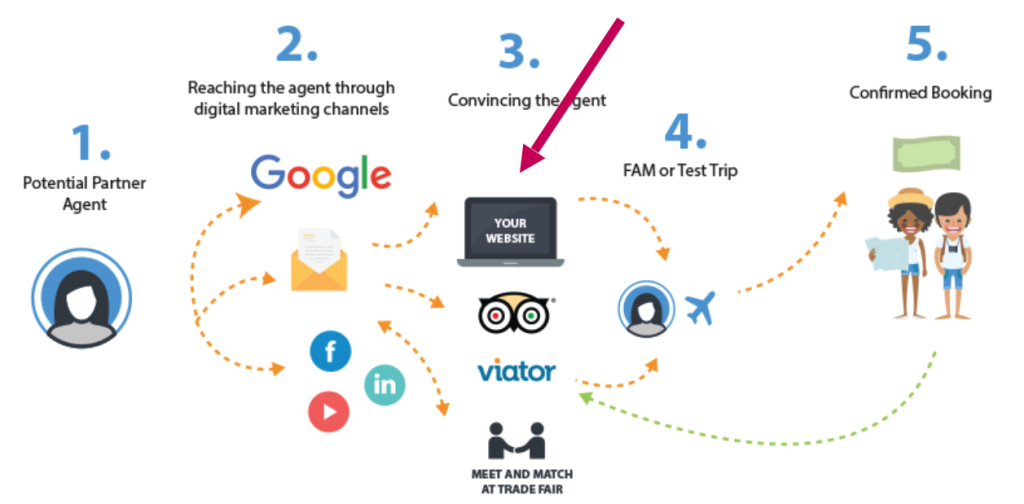
Source: Peter Fabricius/CBI, 2018
The infographic above illustrates the role websites play in the process of generating awareness and securing new business buyers.
- Identify the European partner or partners you believe fit well with your business.
- Reach out via digital channels such as email, Google Business Profile and LinkedIn. You may be able to arrange a meeting with them at a Trade Fair or schedule a call. For more information, download the CBI guide Tips for doing business with European tourism buyers.
- Convince them: They will check out your website once they are aware of your business. What you say on your website will help them decide whether or not to do business with you. Customer testimonials, sustainability actions, expertise and knowledge are all things they will look for.
- Take a FAM trip: They might visit your project in person and/or join a FAM (familiarisation) trip.
- Buy your services: Once they are satisfied with your offer and like how you do business, they will sign you up as a supplier.
Important to understand:
- To attract business customers, your website should be aimed at businesses, not consumers.
- If your website goal is to attract both businesses (B2B) and consumers (B2C), then your website should have a dedicated section aimed at business customers.
- The goals you set for your business website should be service-orientated rather than sales-based.
First Impressions matter: Case Study
B2B is all about being professional. At first impression, your website should convey what your business offers clearly and confidently. Grand Africa Safaris is a good example of this. You can clearly see that they aim their services at businesses and not travellers from the strapline. A strong call to action, ‘schedule a call with us’, is also relevant to the services it is offering. Compare that to ‘book now’, which would be more relevant for a consumer-facing website.
Figure 3: Clear offer from a service-orientated tourism website

Source: Grand Africa Safaris, 2024
The website includes all the most important messages for potential partners on its homepage. Scrolling down, you can see how they expand on their USP in the section ‘Why work with us’, which focuses on the professional services they offer: knowledge, partners, support and independence. Advisor testimonials follow, praising the business for its professionalism. This is followed by a simple process that outlines ‘How to work with us’, which invites the user to browse the website to find out more, schedule a call or join a FAM trip.
From this example, you can see how the website works to build trust and confidence before the potential partner has even got in touch.
Matoke Tours is another B2B website that you should look at as a case study. Look at how they describe themselves. See their call to action, ‘Partner with us’. It gives the visitor a sense of what it would be like to work with them. Ask yourself what your process is when a potential partner gets in touch. How do you provide professional services?
Practical tips: B2B website checklist
When planning your B2B website, take note of these practical tips.
- Be clear about your offer: Focus on the business and services you provide. Use page headings to good effect. ‘What We Offer’ and ‘What We Do’ are good pages to include as you can clearly provide all the information that potential partners need.
- Use relevant call to action: As we have seen, B2B is about building partnerships, not making sales. Make sure your call to action is relevant. Some good examples include: ‘Speak to us’, ‘Meet with us’, ‘Schedule an introduction call’ and ‘Join our webinar’.
- About Us: ‘Meet the Team’ or ‘About Us’ are key pages for B2B websites. Emphasise the story behind your business and introduce the real people behind the business: tour guides, field staff, management and so on. You want to make your buyer feel like they will be working with passionate, experienced experts. Include their contact details too, like email and WhatsApp contact details. Asia DMC provides a good example of a Meet our Team page.
- Products: Promote sample travel plans and destination expertise. Make sure they are presented in an inspirational way, but from a business perspective, not that of a consumer. Do not design a ‘shop style’ website detailing all your tours: this style of website is only suitable for B2C.
Figure 4: Promote trip planning and destination expertise
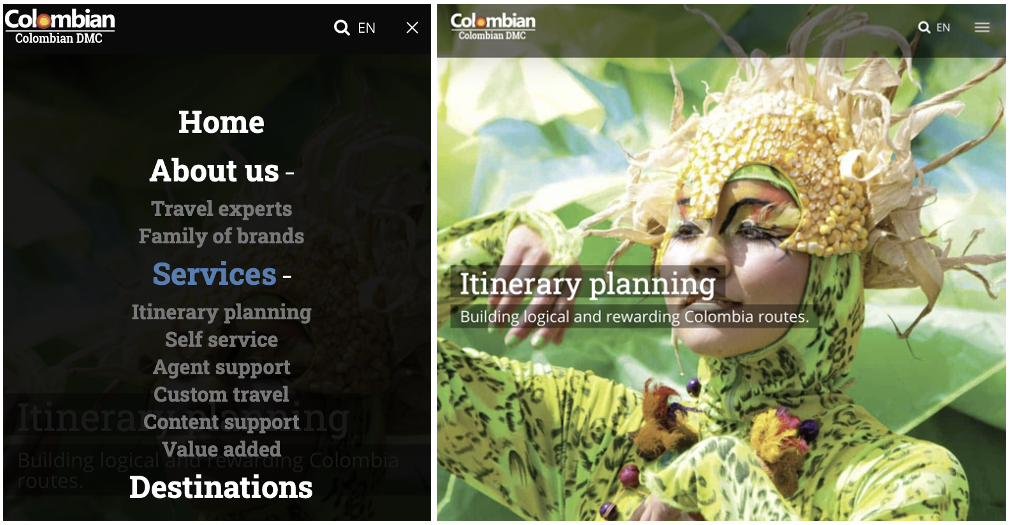
Source: Colombian DMC, 2024
- Post blogs and news: posting blogs and news is useful in B2B marketing, but the content has to be written from a business perspective. Read this blog if you need help writing effective business blogs. Post your blogs on LinkedIn to increase the chance of your target market seeing it.
- Other ways to build trust: List organisations that you are a member of, include testimonials and provide links to press articles in which your business has been mentioned. Consider listing achievements such as how many happy guests you have had, 100% customer satisfaction rate and so on.
- Consider including video content: more websites are including video content to promote their services. Using a profile-style video to introduce yourself and your business to potential business partners is a good idea. You can also use this video when setting up an attendee or exhibitor profile for trade fairs. Have a look at these examples of profile-style videos for Freeland Tours and Travel, and F.K. Explorer Ethiopia Travel & Tours. They are used as business profiles on the B2B platform Ethiopia Travel Specialists. This type of video can be cost-effective compared to the content of destinations and trips.
- Conduct financial, management and resource planning
Consult the sections below for more information about how to create or improve a website and how to produce good content for your digital channels.
4. Develop a digital marketing strategy
Digital marketing is the process of marketing your products online: whether through your website, your social media channels or both. Today, it is the easiest and most cost effective way to reach large numbers of customers. A digital marketing strategy helps to establish the foundation for all your digital marketing activities so that every activity achieves what you expect it to or you can adapt it as required.
Business planning is the first and most essential step to take. It involves conducting financial, management and resource planning. It also involves understanding your business inside out – what niche your business fits into, what your unique selling point (USP) is, who your customers are, who is the competition and so on. Follow these business planning steps as you prepare a digital marketing strategy.
Business planning steps tot take:
- Identify your niche and USP
- Identify your customers
- Research your competitors
- Set goals and objectives
- Evaluate existing digital channels
- Audit current content and plan new content
- Establish a schedule for all digital marketing activities
Conduct financial, management and resource planning
Review your organisation’s financial situation, accounting for your operating costs and making sure that you have priced your travel products appropriately. Assess what in-house resources you have for digital marketing activities and what expertise you may need to commission.
Undertake a SWOT analysis (Strengths, Weaknesses, Opportunities and Threats) to be sure you fully understand where your business is strong and where you can improve. Be very honest when you do this analysis. This way, you can identify what the opportunities and threats are. Have a look at this blog How to make a SWOT for your travel company for help.
Check whether you have the relevant liability insurance policies in place and make sure this is mentioned on your website. European tour operators are required by law to ensure their customers are adequately protected when they travel abroad. They will want to be sure that their suppliers meet requirements. For more information, download the CBI study What requirements do tourism services have to comply with to be allowed on the European market.
Make sure you have a risk management plan in place. The CBI study How to manage risks in tourism? outlines all the steps you need to take.
Identify your niche and USP
Identify your niche and analyse all the tours, trips and holidays that you sell. You should know what is most popular and why. You should not underestimate the importance of knowing what niche your travel products align with. Understanding this will enable you to target your travel products at the most appropriate market. Use the CBI infographic to help you identify which niche or niches your products fall into. The infographic shows you where there is crossover between niches. This may help you spot opportunities to diversify your products into related niches.
Identify your USP (unique selling point). Work out what makes your trips special or different from your local or regional competitors. For instance, if you offer specialist adventure activities, ecotourism or unusual local community-based experiences, this may give you a competitive edge. Alternatively – or in addition – if your business has strong sustainability credentials, you can use them to set yourself apart from the competition.
Insight: Be a sustainable tourism business
Sustainability in tourism is important to European buyers; both businesses and consumers. European tour operators must embed sustainability into their full business chain by European law. They expect local suppliers to do the same. European consumers increasingly appreciate knowing that their travel habits have a positive impact on the planet, places and people. When they travel, the actions they like to do include using more sustainable forms of transport, limiting their use of single-use plastics and travelling responsibly to ensure that local communities benefit. As a local tour operator, you can support them in doing this.
The more sustainable your business is, the more likely it is that Europeans will want to do business with you.
For more information about becoming a sustainable tourism business, consult the CBI studies on sustainability. In particular, download How to be a sustainable business, Tips to go green and Tips to become more socially responsible.
Assess your current brand and objectively consider whether your logo, strapline and other corporate messaging accurately reflect your USP and your niche market’s expectations.
Identify your customers
Ask yourself who your key customers are and what you know about them and their travel preferences.
- If you sell to European tour operators, you should know the profile of the customers they send to you, such as where they travel from, how old they are, what their hobbies are, what activities and/or outdoor activities they enjoy doing and so on.
- If you sell to fully independent travellers (FITs) directly, you should establish a similar profile for them.
Customer profiles are also referred to as ‘buyer personas’. Buyer personas include information like demographics, age, income and type of group, such as family, solo or couples. They also include psychographic information, such as travel habits, motivations and interests, so you have a broader picture of your ideal customer. You can make buyer personas as detailed as you like.
Figure 5: Example of a buyer persona, 2024
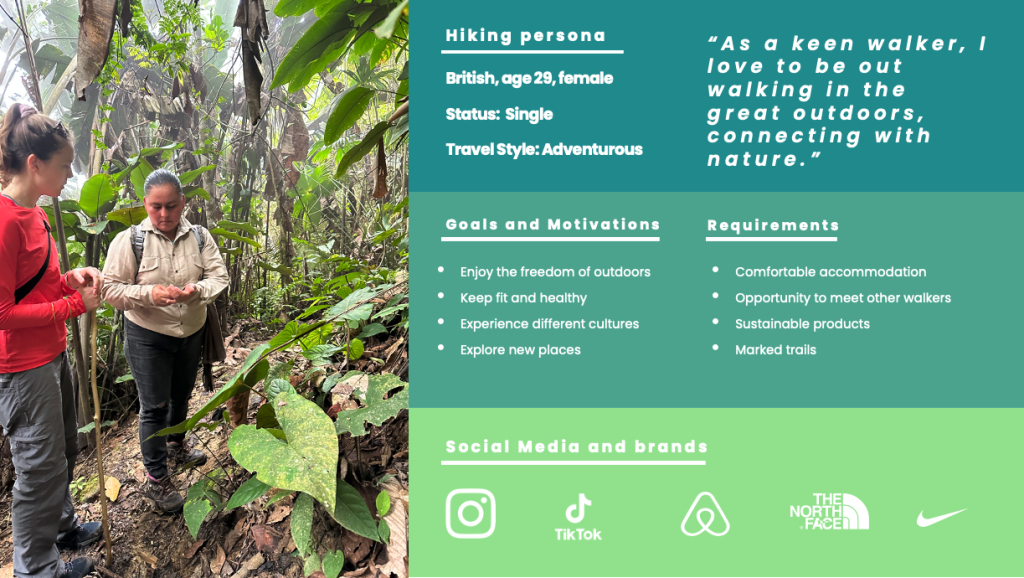
Source: Acorn Tourism Consulting
Do competitor research
Conduct a competition analysis of the other operators in your region or country. Look at their websites to find out what they sell, where they go and how much they charge. Assess all the activities they provide and how they promote them. You can also use this exercise to analyse their websites and pick up any tips that you think work particularly well. For more examples of competing companies, consult the most relevant Market Entry CBI niche market studies relating to your business, and refer to Chapter 3 (this example is about nature tourism).
Set goals and objectives
An important part of a digital marketing strategy is setting goals and objectives. Goals are usually broad and more long-term in scope. Objectives are shorter term and define measurable actions for achieving a goal. Goals and objectives could be improving brand recognition, increasing leads, increasing sales, targeting new audiences or improving your online presence. Goals and objectives should always be SMART: specific, measurable, achievable, relevant and time-bound.
Take a look at the table below to help you set your own goals and objectives.
Table 1: Examples of digital marketing strategy goals and objectives
| Goal: Increase bookings and revenue by (for example, by 20%) in 2025 | ||
| Objective | Actions | Metrics to use for this |
| Increase website traffic (for example, by 20%) year on year for increased brand awareness |
|
|
| Increase booking conversion rate (for example, by 20%) year on year |
|
|
| Increase social media engagement (for example, by 10%) for more engagement with customers |
|
|
Source: Acorn Tourism Consulting, 2024
Evaluate existing digital channels
Review what digital channels you currently use to determine what platforms to include in the new strategy. These include your website, your social media channels and any paid-for advertising. Decide which platforms are most suitable for your strategy.
- If you do not have a website, consider building one. Assess whether your website needs updating or improving. Read the section below: Create or improve your website.
- To help you decide which social media platforms to use, read the section below, Choosing social media platforms.
Audit current content and plan new content
Review the content you currently have across all your marketing channels. Content is essential for SEO (search engine optimisation) and is how you will reach your customers. Content can be text, images, video, links and blogs. It can be generated by the business or, increasingly, as user-generated content (UGC). Content should be planned and developed appropriately for each platform you use.
- Find out more about creating content in the section below: Produce good content for your digital marketing channels.
Establish a schedule for all digital marketing activities
Create a timetable for all your digital marketing activities. This should include activities like producing blogs, posting regularly on social media, launching a competition, promoting a new tour, scheduling paid advertising, monthly email marketing and so on. Microsoft Excel is a useful tool for creating schedules like this. Review and adjust the schedule regularly to account for unplanned events or opportunities that might arise.
“It's easy to feel overwhelmed by the growing number of marketing channels and tools available. A crucial part of a digital marketing strategy is deciding where to invest your resources and where not to. Concentrate on the websites, platforms, and social media channels that align with your strategy and resources and be the best in those areas.”

Peter Fabricius, Bonfire Digital
5. Creating or improving your website
A well-designed website with engaging images, useful and interesting information and well-written content is the window to your business. Most of your customers will find you through your website, regardless of whether they are businesses, FITs or a combination of the 2. Keeping your website up to date, accurate, relevant and inspiring is a key task. If you do not yet have a website, you should consider building one.
Steps tot take:
- Establish clear objectives for the website
- Find a website builder or website designer
- Create a site map
- Include calls to action
- Sections for B2B and B2C as required
- Make your website mobile friendly
- Put someone in charge
- Draw up a timetable
- Website dos and don’ts
Establish clear objectives for the website
Objectives include both sales and marketing objectives. The objectives you set should be based on a thorough understanding of your business, your specialist niche and USP, and who your customers are. See the above section How to develop a digital marketing strategy to find out more about business planning, setting goals and objectives, identifying your niche and USP, and understanding your customers. Another key feature is knowing what actions you want your customers to take on your website.
Find a website builder or website designer
There are 2 ways you can choose to build your website. You can ask a website designer to create a website for you, or you can use a website builder. A website builder is online software that enables users to make their own website from templates. You will not have to use complex coding or be a technological professional. Website builders are usually a cheaper option than employing a website designer and offer Small and Medium sized Enterprises (SMEs) a cost-effective and easy route to creating their own website. Pricing is often based on monthly or annual charges with a one-off set-up fee.
There are many website builders on the market including specialist builders aimed at tour operators. Some examples of site builders – both general and tourism specific – include:
- Tourism Tiger specialises in website design for tour and activity operators and offers template-based options as well as custom design.
- Weebly is easy to use and there are several packages to choose from, including a free website if you feature a small Weebly advertisement on the footer of your website. GoDaddy, Wix and Squarespace are also popular website builders and cater for a wide range of businesses, not just tourism.
- Springnest is a website builder and content management platform for the tourism industry, which focuses on making the process of launching and maintaining a professional website fast and affordable.
- VacationLabs offers a comprehensive website building service for tour operators with a selection of plans. Its online booking system can be added to existing websites.
To find a website designer, do a Google search of website developers in your country or region. Be sure to check they understand tourism websites. Alternatively, check if there is a department in your local university. You may be able to find a student who can create one for you as part of their course.
Create a site map
Make a complete list of all the pages and tours you want to feature on your website. Plan your site map carefully and logically and think about how users are likely to move through the pages. The homepage and main landing pages are the most important ones. They should feature strong headlines. Use text that is easy to read and includes the major keywords and phrases that do not sound stilted.
Start by creating a visual map, like the example below. Then you can build up the individual pages on the site map with more detailed information using an Excel spreadsheet or tables in Word. When you start to build the website, it will help to have everything organised and easily to hand.
Figure 6: Example website site map
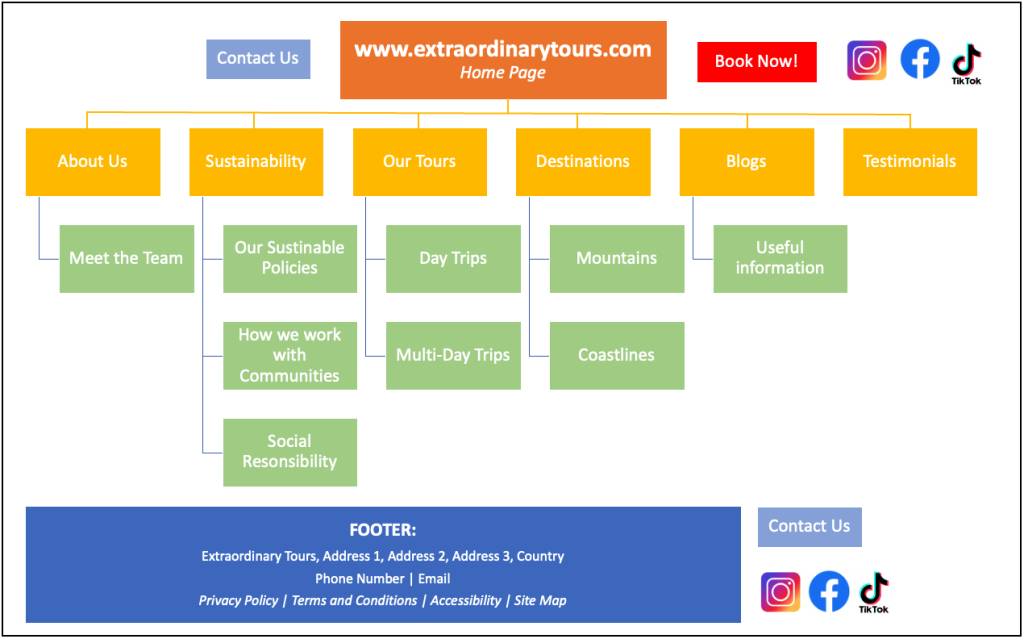
Source: Acorn Tourism Consulting, 2024
Include calls to action
Calls to action (CTA) are essential in any website. They are important because they inspire potential buyers to do what they already want to: find out more, book, get in touch and so on. The most common calls to action the travel industry uses are: Book Now, Contact Us, Check Availability, Reserve, Enquire and Sign up for the free newsletter.
It is important to use a range of CTAs. Not every visitor intends to book immediately. Most potential customers spend time looking at various websites, researching options and pooling relevant information. The more you can encourage them to interact with your website, the greater the chance they will eventually return and book with you. So, you should be creative and work hard to build engagement and trust among visitors to your website.
Include CTAs in different parts throughout your website. The top menu, the sidebar and site footer are important places as they are seen multiple times. Include them in your tour descriptions and blogs too. Do not rely too heavily on Book Now; you may put people off if you use it too often.
Include sections for B2B and B2C as required
If you promote your services to businesses (B2B) and travellers (B2C), you need to dedicate areas of your website specifically to them. Inside Asia, a UK tour operator, primarily markets its website to the consumer market. However, it has a section dedicated to Travel Agents who also buy services from them. Tour operators often indicate their business sites on the top menu and/or footer menu so it is very clear to business users. Another good example is Matoke Tours, a sustainable Ugandan tour operator, which has links to Partner with Matoke Tours on its header and drop down menu.
Consult the section above How to do business online with business partners (B2B) to better understand how to work with B2B online.
Make your website mobile friendly
Your website has to be mobile friendly. This means that it automatically adjusts to the smaller screens of mobile phones and other mobile devices. Increasing numbers of people use their mobile devices to research and book trips. If they have poor experiences on your website, they are unlikely to return or make a booking. All website builders use templates that are mobile-friendly. If you use website developers, it is a question that you must ask.
Put someone in charge
Assign a suitable person or team to lead the project. They should be interested in building the website and have some technological skills so they can navigate the online website builder. They should be responsible for managing the progress and development of the website and generating the content. They should also be responsible for monitoring the website once it is live.
Depending on your resources and skills, website management can either be done by an in-house team or a third-party provider, in which case clear agreements are important.
Draw up a timetable
The end goal is the go-live date for the website. If you create a website from scratch, do not be over-ambitious about your go-live date. Create a realistic time schedule for each step and accept that this project may take a few months to complete.
Website Dos and Don’ts
Have a look at these dos and don’ts for website design. You can find more tips about creating great content and sourcing good images in the next section.
Table 2: The Dos and Don’ts of Website Design
DOs 
| DONTs 
|
| Website Layout | |
Do focus on user-friendliness. Do use common design elements. | Don’t choose a complex layout. Don’t make it too cluttered. Don’t focus on being too creative. |
| Use of Typography | |
Do choose fonts that align with brand style. Do use clear, large headings. Do have lots of space between text elements. | Don’t choose difficult to read fonts. Don’t use more than 3 typefaces. Don’t use a hard to read colour like pale grey. Don’t set continuous text in full capitals. |
| Website Content | |
Do make content informative and useful. Do proofread and make content free of grammatical errors. Do have a content plan. Do include lots of varied call-to-action buttons. Do include customer reviews. Do make contact details prominent. Do make sure contact information is up-to-date. Do include ‘About You’ to build trust. Do include terms and conditions. | Don’t be vague. Don’t include too much text. Don’t overuse keywords. |
| Navigation | |
Do have a simple navigation that is intuitive. Do use the 3-click rule. Do use contrasting colours for text and navigation button. Do focus on content and minimise navigation wherever possible. | Don’t over-complicate the navigation. Don’t change the navigation of each page. Don’t hide critical navigation. |
| Optimising Images | |
Do use images that you have the rights to use. Do add Alt text descriptions on every image. Do resize images to optimise page appearance. Do use high-quality, inspirational images. Do create exciting videos to showcase offer. | Don’t publish photos of someone without their consent. Don’t use poor quality images on your website. Don’t stretch images. |
Source: Acorn Tourism Consulting, 2024
6. Produce good content for your digital channels
Good content must be visually appealing, engaging, inspiring and informative. If it is not, the impact of your website will be lessened. When planning your content, the important considerations should be writing good content and producing and gathering inspirational and informative images and videos.
Write good content
Aim to have a range of pages with written content. They should be well-written, informative, inspirational and compelling. Make sure your text is descriptive and offers insights. You want the reader to believe that you know your destination better than anyone else. Share little-known, unique details wherever you can. Aim for at least 200 words and up to 600 words per page.
Use an editing tool to help you check your text for spelling and grammar, particularly if you are writing for an English-speaking audience. Consider using Grammarly, a free online grammar tool.
Blogs and news are good ways to keep your content fresh and up to date. Blogs provide crucial content for websites. They can showcase specialist expertise and provide detailed, specific information about a topic or range of topics. The more blogs you can post, the better the SEO you will be able to generate.
You should try to publish news items and blogs on a regular basis. It is a good idea to make a timetable for writing blogs and news, and make sure you stick to it. Other team members can also write blogs and news items. It is good to have articles written by different people to offer different perspectives. If you work with influencers, you can commission blogs from them too. See the section below: Work with influencers.
Create a list of appropriate keywords and phrases based on what your buyers search for. Make sure you include the keywords as page titles and include them in the page URL. Use relevant keywords throughout your content. To find out more about researching and using keywords, read this Guide to Find the Best Keywords.
Include relevant links between pages within your site. For example, link from a blog or news item to a relevant tour or link every tour page to a packing or reading list.
Include links to external sites as well as internal links. Be careful to ensure that external links open in a new window rather than in the current window. You do not want to take the user away from your website. Examples of external links could include the national tourist board for your destination or any tourism association that you belong to. If you can encourage a link from their site back to yours, this will contribute high SEO value (see section below Make your website SEO friendly.)
Gather images and videos
Tourism is one of the most visual industries in the world. All travel websites use an abundance of images and videos. It is estimated that 90% of information transmitted to the brain is visual, and it processes images several thousand times faster than words. This means it is essential that you invest time, energy and funds, if necessary, to gather the correct imagery for your website. Your buyers want to visualise the experience you are offering them, be inspired to make that booking and feel confident that they will ultimately enjoy the trip you are promising.
Before you start gathering images, assess what you already have. You may already have a database of photos that you can use. Analyse them thoroughly and ask yourself whether they are truly inspirational and representative of the experiences you offer your guests. Make sure you keep high-resolution versions of your images as master copies. Never edit a master image: create a copy and edit that one. Keep all your images in one place as a directory and create an easy to follow numbering system.
Check out images used by European tour operators, such as Pura Aventura (UK) and Shoestring (Netherlands). You should also look at images and videos used on competing websites and take inspiration from them. Take some time to browse travel accounts on Instagram as it is one of the top social media platforms for inspirational travel images. Pinterest is another platform that features high-quality images that you can explore.
Figure 7: Waterfall in Costa Rica – an example of an inspirational image to use on a travel website

Source: Sterlinglanier Lanier on Unsplash, 2020
There are several ways to gather images and videos. You should aim to build a large database of images that will last you for several years.
- Invest time and money, if necessary, in securing the ‘killer’ images or videos for your homepage. Your homepage will dictate whether people stay on your page, so it is worth investing in.
- Reach out to a local community of photographers or student photographers that you could offer a free trip to in exchange for photos or videos. If you want to pay a professional photographer, make sure you issue a clear brief.
- You can also source still images from online photo libraries like Stocksy and Shutterstock. Generally, they offer a range of plans that may be suitable and affordable.
- Ask your customers to share images with you. If there are any good ones, be sure to ask for their permission before you use them. They are unlikely to say no if you credit them.
- Take your own photos and encourage your staff to take photos when they travel too.
Link your social media accounts to your website
This is an important thing to do when you have social media accounts and a website. As your website has far more information than your social media platforms, you want to drive visits to it. There are several ways to link your socials with your website:
- Include social media icons in the top menu and/or footer that link to your social media accounts directly.
- Include the website link as part of your business profile on all your social media platforms.
- Embed social media feeds into your website.
- Write a blog for the website and post a link to it on Instagram or Facebook.
- Encourage user-generated content (UGC), especially customer reviews from sites like Google and Tripadvisor.
Find out more tips about using social media to enhance your online business in the section below: Choosing social media platforms.
Work with influencers
Influencer marketing is used today by many big and small brands in a wide variety of sectors, including tourism. Growth is being driven by Gen Y and Gen Z, who relate to influencers who inspire them. They trust what they have to say and are engaged with loyal audiences. Travel influencers focus on making, sharing and promoting content related to travel and tourism. Influencer marketing is a fast-moving and constantly evolving environment.
The role of the travel influencer is primarily to generate awareness and inspire their followers about the destination or travel experience they are marketing. Some of the activities they do as part of their role include:
- Travel to new destinations on trips that are paid for by the client, sometimes known as ‘FAM’ (familiarisation) trips. Their trips may also be self-funded.
- Post on their social media channels regularly.
- Produce blogs and/or videos/vlogs showcasing a destination or travel experience.
- Promote businesses, like accommodation or tour operators.
- Write reviews of travel experiences or products.
- Create content for their own channels in collaboration with travel businesses.
- Create guest content for travel businesses’ own channels (for example, their websites).
Working with influencers is becoming more and more essential in today’s digital marketing arena, especially if you are targeting younger consumers. However, remember that older consumers also consult travel blogs when researching their holidays.
Tour Operator Insight: Tips for working with influencers
“Select influencers who truly match your brand and engage with your target audience. Work together closely to tell interesting and true stories. Always know what you want to achieve and keep an eye on how well it works. Use creativity and smart planning to share your message widely and make every connection meaningful.”
Isabel Mosk, Tourism Strategist, Sherpa’s Stories
1. Alignment with the target audience: Ensure the influencer’s audience matches your brand’s target demographic. This includes considering factors like age, interests and geographical location.
2. Authenticity and engagement: Choose influencers who maintain authentic interactions with their audience. High engagement rates (likes, comments, shares) often indicate a loyal and active following. You should check this carefully.
3. Content quality and relevance: The influencer’s content style and quality should resonate with your brand’s image and values. Their ability to create compelling, relevant content can enhance your brand’s appeal.
4. Professionalism and reliability: Work with influencers who are professional and reliable. Look for those with a track record of successful partnerships and who adhere to agreed timelines and deliverables.
5. Unique experiences and creative freedom: Offer influencers unique, memorable experiences they can share with their audience. Allow them the creative freedom to showcase these experiences in a way that feels genuine to their personal brand.
6. Multi-platform strategy: Encourage content creation across various social media platforms to maximise exposure. Each platform can reach different segments of your target audience.
7. Clear objectives and performance tracking: Set clear goals for your influencer collaborations and use tools to track the campaign’s performance. This helps evaluate the ROI (Return on Investment) and plan future strategies.
8. Long-term relationships for authentic endorsements: Aim to build long-term partnerships with influencers. Ongoing relationships lead to more authentic endorsements and a stronger connection with their audience.
9. Transparency and clear communication: Ensure transparency in your partnerships by clearly communicating expectations, deliverables and compensation. Open communication builds trust and fosters successful collaborations.
10. Diverse influencer portfolio: Consider working with a mix of influencers, including micro-influencers, who can often boast high engagement rates and niche audiences. A diverse influencer portfolio can effectively extend your reach to various customer segments.
For more information about influencer marketing, consult the CBI study How to work with influencers.
Make your website SEO-friendly
SEO (search engine optimisation) is the process of improving your website to increase its visibility on Google and other search engines. Search engines like Google, Bing and Yahoo send out ‘crawlers’ (or ‘spiders’) over the web to identify the most relevant websites based on the user’s search request. The websites that score highly are those that appear on the first search page. Most users do not go further than the results on the first page.
Good content is essential for SEO, and the quality of travel websites is increasing all the time. Well-written, relevant content with frequently-used keywords, images and videos all contribute to SEO. Tips for improving SEO for your website are given below.
- Use keywords to enhance SEO. Make a list of all the keywords you can think of. Include them appropriately in all your content, making good use of them on landing pages, headings, blog posts, meta descriptions and social media content. However, do not overuse them: once in one sentence is enough. Google penalises the overuse of keywords.
- Enabling customer reviews on your website (for example, Tripadvisor, Google) also contributes to SEO.
- Optimise your images. They should be high resolution and compressed for fast loading. Always add ‘Alt Text’ (a description of the image) and relevant captions to images on your website.
- External links and links to social media platforms also enhance SEO. Reach out to the local tourist board and see if you can link to their website and ask them to link to your website in return.
- Make sure you are listed in local business directories and local listings. Embed maps on your website and use location-specific keywords. This will help Europeans find your website when looking for things to do in the destination.
- Having a mobile-friendly website also enhances SEO.
Website Best Practice Examples
Kara-Tunga has a detailed website with several relevant sections. Each section has lots of pages to encourage the user to dig deeper and find out more. For instance, the ‘Responsible Travel’ section includes pages on sustainability, safety, ‘good to know’, tourist code and more. A useful ‘Things to Do’ section highlights activities by region. The ‘Travel Guide’ section provides more helpful information.
Browse the site to see how intuitive it is and how easy it is to find your way around. A wider variety of calls to action would make this website even better.
Apus Peru opens with a call to action that encourages people to sign up for 6 genius tips and find out more about getting an Inca Trail permit. Its site map is easy to navigate and has lots of interesting information, images and videos to keep users’ attention. Note how this operator prominently states its sustainable, responsible and ethical principles on the homepage.
Sam Veasna Conservation Tours has a strong homepage with lots of useful and detailed information. It also features customer testimonials, which are inspirational. The operator makes good use of images and introductory text to encourage users to dig deeper into the website. There are also plenty of calls to action, like downloading a catalogue and following on Instagram.
A large section of the website is dedicated to sustainability and the work it does in conservation and community empowerment. It also provides a personal touch, inviting the user to meet the local guides who are expert birders in the form of videos.
7. Take online bookings
There are 2 main ways of making bookings online. You can enable your website to take bookings online. You can also list your tour or tours with an online travel agent (OTA), like Viator or GetYourGuide, and the OTA will handle all payments for you.
Make direct sales through your website
People like to make bookings that are instantly confirmed. If your website is optimised for direct bookings, you are likely to make more bookings. If you build a new website, most website builders offer an e-commerce package. There are plenty of good reasons for enabling online booking and payments, as you can see in the table below.
Table 3: The benefits and disadvantages of an online booking and payment system
| Benefits | Disadvantages |
Saves your staff time No need to manually synchronise diaries No double-booking problems Enables you to align calls to action alongside relevant content Ability to upsell additional services/activities Can be aligned with OTA booking systems | Can be costly to set up Requires internet access |
Source: Acorn Tourism Consulting, 2024
If you already have a website and want to enable online bookings and payments on it, the first step is to find out whether your current website platform can do this for you. Alternatively, there are several booking systems specially developed for the tour operator market, such as Trekksoft and Bókun.
You must ensure that your payment system can handle the major online payment methods, including credit and debit card payments and PayPal. PayPal has become a popular method of online payments that allows users to check out without having to enter their financial details every time.
Before deciding on anything, consider what you need from an online booking and payment system. Europeans are more likely to book multi-day trips or holidays through European tour operators and are less likely to book directly with local operators. However, FITs that plan day trips or short experiences are more likely to make spontaneous bookings with local operators once they arrive at the destination or before they arrive.
Of course, you can also take manual bookings whereby customers make bookings through your website contact form and pay for the tour later or pay in advance by bank transfer. However, you have to be very organised, especially if you also sell your tours through an OTA. It is important not to overbook a tour by mistake or not record a booking. There is also a risk that the customer might not turn up if you do not take payment in advance.
Work with OTAs
OTAs are online marketplaces that local tour operators can use to sell their tours. They are important sales channels for SMEs as they reach a wider market and can generate additional bookings. OTAs that specialise in trips, guided tours and experiences are the fastest-growing sales platforms for day and multi-day trips and tours.
Figure 8: Use stunning photos to illustrate your tours on an OTA platform
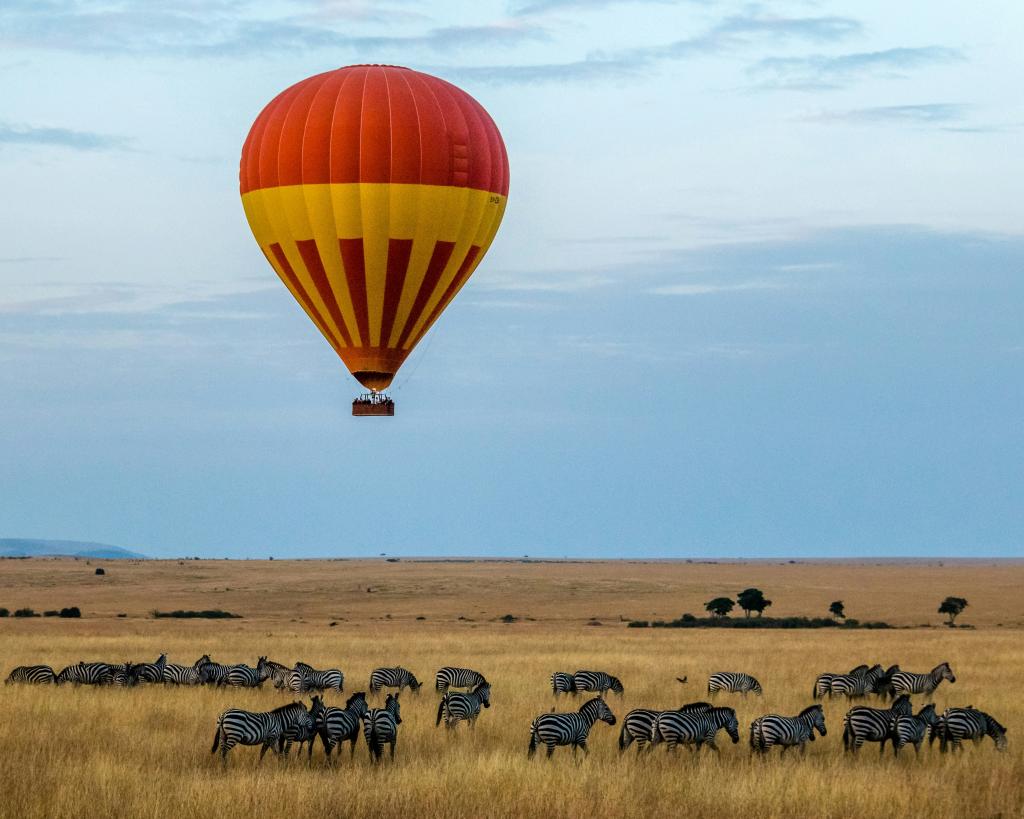
Source: Surtirta Budiman at Unsplash, 2018
There are more than 400 OTAs on the market. Some of the most popular in the European market are GetYourGuide, Viator, Klook and Musement. Some OTAs specialise in specific niches, such as Traveling Spoon (food experiences), Lokal Travel (community-based tourism experiences) and Indy Guide (local guides and tours in Central Asia).
If you connect with several OTAs, it might be worth investing in a channel manager to automatically synchronise all your sales channels. The Trekksoft Channel Manager is an option developed for the tour operator market.
Table 4: Benefits and disadvantages of working with OTAs
| Benefits | Disadvantages |
|
|
Source: Acorn Tourism Consulting, 2024
The questions you should ask yourself before committing to working with an OTA are:
- Will the OTA find you the right sort of customers for your trip or experience?
- What commission do they charge, and is it affordable? Do you have leverage to negotiate? For example, do you provide an experience that is significantly different to anyone else on the market?
- Can you make the relevant processes (checking availability, booking, payment) work between your business and those of the OTA?
- Are the OTA’s T&Cs (terms and conditions) acceptable to you? You should check their cancellation and refund policies to ensure they are not punitive. Negotiate better deals if you can.
- How will you be paid, and in which currency? Will there be conversion fees and, if so, do you find them acceptable?
The dos and don’ts of working with OTAs
You will need to do lots of research and preparation before working with an OTA. All OTAs are different, so you need to be sure you’re signing up for the right one. Have a look at these dos and don’ts while you conduct your own research.
Table 5: The dos and don’ts of working with OTAs
DOs 
| DONTs 
|
| Working with OTAs | |
Do start small. List one or 2 products to start with so you are familiar with the setup and can make sure that everything goes according to plan. Do keep it simple. Do not over-promise to the customer or risk disappointing reviews. Do make it unique. Research what your competitors are doing and see how you can make your tour different and stand out. Do be flexible. If you can accommodate same-day or last-minute bookings, you may get more business. Do work on producing good content. Text and images should be authentic and compelling. Do invest in good copywriting and photography skills. | Don’t rely on OTAs for all your sales. If circumstances change and you cannot afford the commission they charge or the OTA goes out of business, you will lose your only sales platform. |
Source: Acorn Tourism Consulting, 2024
For more tips on working with OTAs, read the CBI study How to work with OTAs.
8. Choose social media platforms
Social media is used to raise brand awareness and drive users to interact with your brand. They do this through ‘call to actions’ – like, share, follow, comment, visit your website, make a purchase and so on. It is important to choose the right social media platform. Use the table below to understand the difference between them and use the one that you feel fits best with your target audience.
Table 6: Social media platforms used by travel businesses
| Platform | What it does best |

| Social networking site to connect and share with family, friends and customers.
Good Business Examples: TUI; American Airlines, Visit England Three billion active monthly users in 2024 |
YouTube 
| Long and short-form video platform.
Good Business Examples: 2.7 billion active monthly users in 2024 |
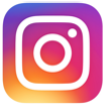
| Social networking site centred around photographic content. Builds brand awareness. Excellent for generating UGC.
Good Business Examples: Expedia, Lonely Planet, Airbnb, Intrepid Travel 1.4 billion active monthly users in 2024 |
TikTok 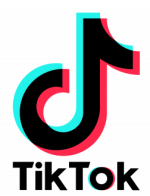
| Short-form video platform.
Good Business Examples: Ryanair, San Diego Zoo, Hostelworld 1 billion active monthly users in 2024 |

| Social networking site for B2B and professionals in the industry.
Good Business Examples: 1 billion active monthly users |
X 
| Online news and social networking site
Good Business Examples: Visit Scotland; Turkish Airlines, Hilton Hotels 528 million active monthly users |

| Highly visual, online pinboard/bookmarking site that uses destination-themed keywords. Good Business Examples: 482 million active monthly users in 2024 |
Source: Acorn Tourism Consulting, 2024
Tripadvisor is the world’s largest social media platform for travel research. It is the leading review site for all types of tourism businesses and provides millions of recommendations from travellers. It is the most widely used travel site and one of the best ways to generate positive online reviews. Bookings are redirected to its sister platform, Viator.
However, it is important that you know how to deal with any negative reviews effectively and turn them into a positive. Read the blog Handle bad reviews like a boss for some good tips.
The dos and don’ts of social media
Table 7: The dos and don’ts of social media
DOs 
| DONTs 
|
| All Platforms | |
Do set your profile up as a business account. Do upload a logo as your profile picture. Do upload a high-quality photo as your cover photo. Do provide links to your website. Do have a concise intro of your business. Do provide correct company information. Do have a call to action (contact, book online). Do link to your online booking platform (OTA or website). Do enable guests to leave feedback/reviews. Do link social media accounts. | Don’t forget to keep your business information up to date, such as contact details and opening times. Don’t forget to regularly check that all links still work. Don’t forget to regularly assess and review content. |
| Photos and Hashtags | |
Do make sure photos are crisp, in focus and engaging. Do ask your guests if you can use their photos. Tag or mention them when sharing it. Do provide a good mix of images and content, not only about sales. Do tag the location where the picture was taken. Do tag customers, employees, and local businesses. Do use hashtags. | Don’t use blurred photos or poorly cropped images. Don’t stretch photos so they are out of proportion. Don’t use too many hashtags. Between 1 and 5 is enough. |
| Captions | |
Do make your captions engaging. Do include the location. Do check that the spelling is correct. Do provide tips and recommendations. Do use paragraphs if there is a lot of content. Do include a call to action, such as click the link, save a post for later, post a comment, follow us to see more, find out more, tag a friend or send a message. | Don’t write in capitals. Don’t write short, unengaging content. Don’t make spelling mistakes. Don’t go off-topic and talk about personal or irrelevant subjects. Don’t make it too sales-oriented. |
| Video and Photo Content – Stories (Facebook and Instagram) | |
Do use polls/stickers/ask questions to increase interaction and engagement. Do save key stories as highlights so they can be accessed and viewed at any time. Do re-share good quality posts that you have been tagged in. Do tag locations, people and other businesses – they may tag you back. | Don’t post too much or it may overwhelm people. Don’t be unprofessional. Always check content before posting. Don’t share content that is not real or authentic. |
| Video Content – Reels and Shorts (Facebook, Instagram, TikTok and YouTube) | |
Do share original and authentic content, created with the Instagram Reels camera. Do stay up to date with cultural movements and topics. Do keep it intriguing to engage the visitor quickly. | Don’t add music other than from the Instagram library unless you have a license. Don’t post anything you don’t own or have permission to share. Don’t post anything irrelevant or that lacks a storyline. |
| Video Content – Long Form Videos (YouTube) | |
Do use high-quality engaging video content. Do keep it engaging. Do re-share good quality posts that you have been tagged in. Do post links to your videos on your other social media platforms. | Don’t post all your content on one day. Don’t upload content that is too long. Don’t share content that is not real or authentic. |
Source: Acorn Tourism Consulting, 2024
Tips:
- Do not try and use all social media platforms if you are new to using social media. Choose one or 2 platforms, keep it simple and invest time and effort into using the platforms really well. This way, you can add other platforms once you are completely confident that you understand how they work. Instagram is currently the most important platform for travel.
- Assign responsibility to someone who is familiar with and enjoys social media to manage your accounts and campaigns. Ideally, they should be an expert in social media and familiar with using hashtags, emotive text, posts and so on.
- Interact proactively with the travel industry through social media. Find accounts of competitors, tourist boards, accommodation providers and associations. Like their posts, images and videos, and you can even post and respond to comments. Someone might like yours in return, and it will all help you become more visible. Engage with online communities that are relevant to your niche, such as birder groups or extreme adventurers. See this Birdwatching Community on Facebook as an example.
9. Use artificial intelligence (AI) in tourism
The tourism industry is widely using AI. Large travel websites like Tripadvisor use AI to personalise search results. Hotels are also big users of AI, using it to personalise experiences for their guests, manage pricing and operate chatbots.
Chatbots are one of the simplest and most cost-effective forms of AI. They can answer a range of queries easily and fast and are widely used in the travel industry. Find out how to install a ChatBot using Chat Widget or talk to your website builder/website developer.
Generative AI, or ‘GenAI’, is capable of generating text, images, videos and even music using generative models. ChatGPT is the best known and biggest innovation, growing from zero to 100 million users in just 3 months, faster than any other form of AI technology. There are several tools on the market, including Google’s Gemini (recently rebranded from Bard), Claude AI and Microsoft’s Bing Al Chat. They can be useful business tools to create short-form content using original content. For instance, as a tour operator, you could ask it to suggest a catchy name for your tour or ask it to create a summary for your tour from the information you provide it.
Other GenAI tools can generate images and professional designs, like Canva. Tools like Synthesia use GenAI to create high quality videos just from text. There are also GenAI tools that create music inspired by a few bars or a melody or text. Google’s MusicLM was released in 2023.
From a consumer perspective, travellers can use GenAI to find holiday inspiration. Research has found that one third of travellers would use ChatGPT to plan their holiday. There are even blogs and videos to help consumers start with their travel planning.
Tips:
- Practice using an AI platform to create content for your website. If English is not your first language and you are writing for an English-speaking audience, insert some text you already have and ask the platform to rewrite it in descriptive English.
- Experiment with other platforms like Canva to improve your marketing materials.
10. Benefit from online marketing and advertising
Organic, or free, search engine marketing takes time to build up and relies on excellent content and the use of keywords. It may not always get you the results that you want, particularly as search engines and social media platforms regularly change how they rank websites and the way social media posts are shared.
You should consider some form of paid for marketing to supplement the hard work you do to generate good content. When you pay for advertising, it is important that you regularly monitor the performance metrics, such as cost-per-acquisition and return on advertising spend, so you can judge the success of the campaign.
Pay per click advertising
Pay per click advertising (PPC) is one of the most common online advertising techniques. Over 50% of internet users click on a sponsored result; these are the advertisements that appear above organic search engine results. PPC, like other marketing tactics, costs money. With PPC, money is paid to the search engines when a sponsored ad is clicked. When used correctly, it can drive an influx of relevant traffic to the website.
The benefits of PPC are that it is measurable and can be more cost effective than other paid advertising as the sponsor only pays when their ad is clicked on. All the major search engines including Google, Bing and Yahoo offer PPC advertising. You can read more about PPC on Google Ads.
Conduct an online search to learn more about advertising online. The Complete Guide to Online Advertising for Tour Operators would be a good place to start.
Digital advertising on social media platforms
Digital advertising on social media platforms by travel professionals is reported to be growing, accounting for almost half of all advertising spend in 2018. You can pay to place advertisements on all the major social media platforms including Facebook and Instagram; click on the links to find out more about each option. This blog, 5 Best Travel Facebook Ad Examples (And What Works), showcases some interesting examples of advertising campaigns along with the results they achieved and the advertising format used.
Use Google Business Profile and Things to Do on Google
Google is a useful platform with tools that are particularly helpful for SMEs and local businesses. Google Business Profile allows you to grow your online presence, and you can list your business on Google maps. You can display important information about your business. This is great for creating a local presence. Some travellers may find your business this way when they are in your destination. Find out more about why a Google Business Profile is important.
Google Things to do allows tour operators to list their tours on Google for free. At the moment it is best to do this via an OTA. Google is constantly updating and improving this feature. Watch this useful YouTube video. It explains how to use Google’s Things to do or read Google’s Introducing Things to do on Google. See these examples of a Google Business Profile and a Things to do search.
11. Continuously monitor and evaluate your online activities
Now that you have a website and social media platforms, you have to regularly monitor and evaluate how they perform. This is important so you can react to things that happen, make changes as required and take advantage of opportunities as they arise.
Website analytics
Your website is the first place you should gather and analyse data. Make time to assess the health of your website to find out how well it performs. The metrics you should monitor are listed in the table below.
Table 8: Website health and metrics to monitor
| Monitoring Website Health | Website Analytics and Statistics |
Website Speed: If your website is slow, users will become impatient and find another website. Mobile Responsiveness: Google will reduce traffic to your site is if it not responsive on mobile. Keyword Optimisation: Having the right keywords in the correct places on your pages is important so they appear in search results. Server Reliability: Health checks monitor if your website goes down and for how long, and how fast the server provided by your hosting service is. This will help you assess if your hosting service is performing to the agreed specification. Page Errors and Broken Links: Issues such as ‘404 Page Not Found’ errors make it hard for users to navigate a website. | Number of Visitors: Total number of people who visit your website. Bounce Rate: These are visitors to your website from a search engine like Google or Yahoo but who click off your site after viewing just one page. A high bounce rate affects your SEO negatively. Average Page Views per Session: How many pages the visitor has browsed. Session Duration: The more clicks, the higher the metric. Average Time on a Page: This measures engagement with a page. Top Traffic Source This is where your visitors have found your page from, such as Instagram, Facebook, YouTube, Google search or email newsletter. Device Source: How the website is accessed, such as through a laptop, tablet or mobile. Interactions per visit: This shows what they click on and what actions they take. Exit Pages: This is where people decide to leave your site. |
Source: Acorn Tourism Consulting, 2024
Google has a number of useful tools that are free to use. Google Analytics tracks and reports traffic to your website. It is free to use and provides information, such as where users are based, which pages they look at, how long they stay on your website, what type of device they use and much more.
Google Trends is a search trends feature that enables you to analyse and compare popular search terms and trends. It is free to use. You can also apply filters such as location, dates and categories. Read this blog How to use Google Trends to gain a competitive edge and for some tips on using it to help your business.
Google Looker studio is another free tool that can help you turn your data into useable content that is informative, easy to share and read, and can be turned into a customisable dashboard. To find out how it works, read Google’s Looker Studio Help post.
There are companies that can measure your website statistics for you, like Ahrefs and Semrush.
Social media metrics
Every social media channel has built-in tools to analyse performance.
- Facebook Audience Insights – see how people engage with your Facebook page, understand your audience and track your Facebook advertising performance.
- Instagram Insights – learn more about overall trends across your followers and how your content performs with your audience.
- X Analytics – understand the performance of your paid and organic posts
There are companies that can manage and analyse all your social media marketing activities for you, like Hootsuite and Sprout Social. They also provide lots of useful information about social media marketing.
Acorn Tourism Consulting Limited carried out this study on behalf of CBI.
Please review our market information disclaimer.
Search
Enter search terms to find market research

